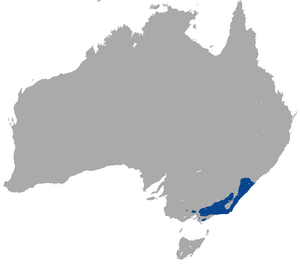Mountain brushtail possum facts for kids
Quick facts for kids Mountain brushtail possum |
|
|---|---|
| Conservation status | |
| Scientific classification | |
| Genus: |
Trichosurus
|
| Species: |
cunninghami
|
 |
|
| Mountain brushtail possum range | |
The mountain brushtail possum, also called the southern bobuck (Trichosurus cunninghami), is a nocturnal animal. This means it is active at night. It is a marsupial that lives mostly in trees in southeastern Australia. Scientists only officially described it as its own species in 2002.
Contents
About the Mountain Brushtail Possum
In 2002, scientists looked closely at the mountain brushtail possum, which was then known as Trichosurus caninus. They thought it should be split into two different species. The possums living in the northern parts kept the name T. caninus and became known as the short-eared possum.
The possums found in the Victorian Alps kept their common name, mountain brushtail possum. But they were given a new scientific name, T. cunninghami. However, some genetic studies suggest that these two groups might not be different enough to be separate species.
In 2005, a group of these possums was found in a swampy coastal area in south-west Gippsland, Victoria. This discovery showed that these possums live in more places than just mountains. Because of this, the name "mountain" brushtail possum might not be the best name anymore. Some people suggest calling the northern group the "northern bobuck" and the Victorian animals the "southern bobuck" (T. cunninghami).
What They Look Like
Both the mountain brushtail possum (T. cunninghami) and its relative, the short-eared possum (T. caninus), are medium-sized animals. They usually weigh between 2.5 and 4.5 kilograms (about 5.5 to 10 pounds). They are nocturnal marsupials that spend a lot of time in trees.
These possums are typically found in wet sclerophyll forests. These forests are in southeastern Australia, along and east of the Great Dividing Range. They usually live at altitudes higher than 300 meters (about 980 feet).
Diet and Habitat
The mountain brushtail possum and the short-eared possum have more specific needs for their food and homes than the common brushtail possum (T. vulpecula). This is why the common brushtail possum can live in many different places, including cities. Bobucks, however, are not found in urban areas. They prefer stable forest environments.
During the day, mountain brushtail possums sleep in hollows inside trees. Sometimes they might hide in thick plants on the ground. At night, they come out to find food. In mountain areas, they mostly eat Acacia trees, especially the Silver Wattle.
However, in lowland Gippsland, these possums don't stick to one type of plant. They can be found in different kinds of Eucalypt forests or in Tea Tree areas. Mountain brushtail possums also eat food found on the ground. This includes different types of fungi and ground-level plants.
Having enough trees with hollows for dens is very important for the mountain brushtail possum. The number of hollow trees and Silver Wattle plants can affect how many possums live in an area in Victoria.
Reproduction and Life Cycle
Male and female mountain brushtail possums look very similar. They mate during a 2 to 3-week period in autumn (March to June). Most females will have one baby each year. The males do not help care for the young.
Baby possums stay in their mother's pouch for several months. After that, they ride on their mother's back. During the summer (December to February), the young possums start to walk with their mothers. This helps them learn to be independent.
Both males and females must be at least two years old before they can have babies. Female offspring often stay close to where they were born. Young males, however, might travel up to 8 kilometers (about 5 miles) away. Once they are old enough to reproduce, mountain brushtail possums usually keep the same home range for their entire lives.
These possums can live for a very long time. They might even be the longest-living marsupial species!
Recent studies show that how mountain brushtail possums mate can vary. In one study, two groups of possums were observed. One group had a mating system where one male mated with many females (polygynous). The other group had one male mating with one female (monogamous). These two groups lived only 2 kilometers apart. The polygynous group lived in a long strip of habitat along a road that had not been logged for over 100 years. The monogamous group lived in a forest that had been logged 40 years ago. Scientists are still trying to figure out if the shape of the habitat or the quality of its resources causes these differences in mating systems.
See also
In Spanish: Trichosurus cunninghami para niños


